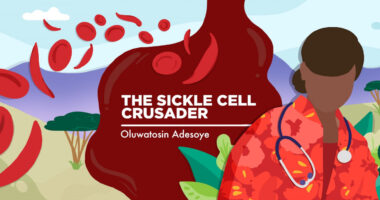What to consider when developing a clinical trial for sickle cell patients
A columnist shares ideas for overcoming obstacles to sickle cell research

Research is essential for change. For example, researching different diets and exercise regimens has helped me learn how to better manage my sickle cell disease. I’m open to discovering new techniques because no one drug or treatment will work for everyone.
I’m also keen to learn about new clinical trials for sickle cell patients. With my clinical background in the research and development field, I’ve developed a genuine appreciation for trials and the development of novel treatments.
I’m disappointed, however, by the number of clinical trials available to sickle cell patients here in the U.K. Sickle cell disease is the fastest growing genetic condition in our country, but despite all the advancements in genetics, our community lacks the research it needs.
I thought there’d be more options available, even though sickle cell is considered rare in this part of the world. During a discussion with a private company interested in doing a clinical study for the sickle cell community, I realized just how many obstacles there are. If the research is done correctly, however, I believe there are workarounds to the challenges I identified.
Design
The unpredictable nature of sickle cell can make a regulated trial difficult. What if the participant has a crisis and can no longer do the trial procedures or attend a clinic visit? How can researchers ensure the participant is relaxed and feels no additional strain?
Ultimately, you can’t predict how sickle cell will affect each person, but researchers can make adjustments. There are multiple ways to accommodate participants, such as home health visits or remote clinic visits, which can ease the burden.
Development
Sickle cell affects Black people more than other communities because it’s an evolutionary trait people developed to provide malaria resistance. However, research into ethnic minorities comes with complex challenges, such as culture, religion, and mistrust. After all, these communities are marginalized in society and the healthcare system, making it difficult for clinical research to happen.
To overcome these challenges, working with these communities during every step of the research process is essential. Developing relationships with participants and understanding the stigmas and barriers they face can improve the quality of the research. When creating a study, researchers must engage the community, including patient advocates, caregivers, and allies, to ensure the research not only works on paper, but also adds value to the underserved community.
Recruitment
Almost every sickle cell patient has a horror story of how they were treated in the hospital. These incidents can leave lasting scars, making it difficult for researchers to engage with sickle cell patients in healthcare settings. Therefore, asking doctors or nurses to recruit participants might not be the best option, as relationships can be strained.
It’s essential for researchers to understand why sickle cell patients may hesitate to join a trial. So how can we overcome the emotional trauma these communities have experienced to engage them? Recruiting participants outside of the hospital or via trusted organizations or community members could help.
Follow-up
In my experience, there’s always a need for follow-up in clinical trials or patient advisory groups. I’ve worked with organizations that are initially interested and engaged, but communication stops once they have their results. This can be disheartening, causing participants to wonder if the organization truly cares about the community.
Reporting back to patients is crucial, whether progress is made or not. Providing feedback creates transparency and helps researchers maintain relationships with patients, which can be helpful for future studies. Sickle cell research must be inclusive, adaptive, and consistent to make genuine positive change.
Note: Sickle Cell Disease News is strictly a news and information website about the disease. It does not provide medical advice, diagnosis, or treatment. This content is not intended to be a substitute for professional medical advice, diagnosis, or treatment. Always seek the advice of your physician or other qualified health provider with any questions you may have regarding a medical condition. Never disregard professional medical advice or delay in seeking it because of something you have read on this website. The opinions expressed in this column are not those of Sickle Cell Disease News or its parent company, Bionews, and are intended to spark discussion about issues pertaining to sickle cell disease.








Leave a comment
Fill in the required fields to post. Your email address will not be published.